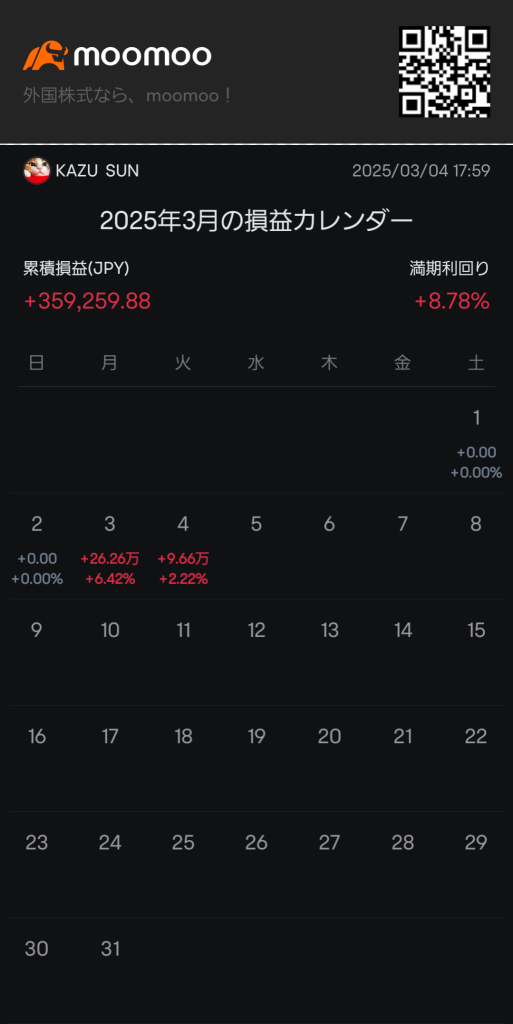いぬかん
commented on
$Palantir (PLTR.US)$ It would be better to be prepared to turn 60...
Translated
3
4
いぬかん
liked and commented on
No matter how much money one has, if they become ill, many things cannot be done.
And without time, one cannot do what they wish.
Do what can be done now to the best of one's ability.
Making the most of the present is proof of being alive!
Gorilla Technology GRRR
And without time, one cannot do what they wish.
Do what can be done now to the best of one's ability.
Making the most of the present is proof of being alive!
Gorilla Technology GRRR
Translated
31
6
いぬかん
reacted to
It's not written to scare anyone.
It's about the fact that anyone can make mistakes.
Of course, including myself, it shouldn't be that anyone likes to make mistakes.
I have also experienced losses from "misjudgment" and "bad news" that appeared at unexpected times many times.
The reason I have never started a year in the negative is simply because the foundation is solid, and I am prepared to follow up on losses (either through wisdom or experience).
Even when buying what I thought were quality stocks, there are countless examples of having to cut losses when their prices fell.
One example since the beginning of this year is, of course, JVA.
$Coffee Holding (JVA.US)$
In a market where many people sell when prices are high.
Moreover, there is the Shell PLC ADR shelf offering.
By registering new shares without selling all the shares, of course, the number of shares in the market increases, and their value decreases.
No one could have predicted this.
If there were someone who managed to escape successfully, it would make one suspicious of those who knew about this 'plan'.
It's pointless to say it now, but in the future, it is certain that such 'unexpected' situations will arise...
It's about the fact that anyone can make mistakes.
Of course, including myself, it shouldn't be that anyone likes to make mistakes.
I have also experienced losses from "misjudgment" and "bad news" that appeared at unexpected times many times.
The reason I have never started a year in the negative is simply because the foundation is solid, and I am prepared to follow up on losses (either through wisdom or experience).
Even when buying what I thought were quality stocks, there are countless examples of having to cut losses when their prices fell.
One example since the beginning of this year is, of course, JVA.
$Coffee Holding (JVA.US)$
In a market where many people sell when prices are high.
Moreover, there is the Shell PLC ADR shelf offering.
By registering new shares without selling all the shares, of course, the number of shares in the market increases, and their value decreases.
No one could have predicted this.
If there were someone who managed to escape successfully, it would make one suspicious of those who knew about this 'plan'.
It's pointless to say it now, but in the future, it is certain that such 'unexpected' situations will arise...
Translated
42
22
2
いぬかん
Set a live reminder
$NVIDIA (NVDA.US)$ On March 19, 2025, at 2 AM Japan time, a keynote speech is scheduled to be held at GTC.
Top developers, innovators, and corporate leaders will gather to explore how AI and high-performance computing cansolve complex challenges in the financial markets.The evolution of AI agents, robotics, and accelerated computing infinancial technology.?ジェンスン・フアンCEOが語るAIの最新動向から、フィンテックの未来を読み解き、業界トレンドを把握しましょう!
プレゼンテーションはwill be delivered in subtitle translation format.配信されます。視聴をご希望される方は、「Book" button.
◆Notes
The content of this live event is provided for the convenience of customers through a subtitle translation service. The subtitles are generated using Microsoft Azure and Amazon Translate. No explicit or implicit guarantees are made regarding the accuracy, reliability, or correctness of machine translation from English to Japan.
Top developers, innovators, and corporate leaders will gather to explore how AI and high-performance computing cansolve complex challenges in the financial markets.The evolution of AI agents, robotics, and accelerated computing infinancial technology.?ジェンスン・フアンCEOが語るAIの最新動向から、フィンテックの未来を読み解き、業界トレンドを把握しましょう!
プレゼンテーションはwill be delivered in subtitle translation format.配信されます。視聴をご希望される方は、「Book" button.
◆Notes
The content of this live event is provided for the convenience of customers through a subtitle translation service. The subtitles are generated using Microsoft Azure and Amazon Translate. No explicit or implicit guarantees are made regarding the accuracy, reliability, or correctness of machine translation from English to Japan.
Translated

NVIDIA GTC 2025 Keynote: Exploring the Next Moves in the AI Revolution (with Japanese subtitles)
Mar 19 01:00
26
2
2
$Ultra Clean (UCTT.US)$ Here it comes. The only thing left is to rise.
Translated
3
1
いぬかん
Set a live reminder
On March 5, 2025, at 11 a.m. Japan time (Wednesday), President Trump's joint congressional address is attracting attention in the global financial markets.
The main focus points are as follows.
1. Strengthening tariffs against Mexico, Canada, and China.
2. Large-scale infrastructure investment plan
3. Technological competition with China
4. Reevaluation of the fossil fuel industry
This speech could represent an important turning point for the financial markets in 2025. With market fluctuations expected, careful determination is required on how investors should position themselves. Please be sure to watch the live broadcast.
This event iswill be delivered in subtitle translation format.It will be streamed. Those who wish to watch, please say "Book" button.
◆Notes
The content of this live broadcast is provided for the convenience of customers through subtitle translation services. The subtitles are generated using Microsoft Azure and Amazon Translate. There are explicit disclaimers regarding the accuracy, reliability or precision of machine translation from English to Japan.
The main focus points are as follows.
1. Strengthening tariffs against Mexico, Canada, and China.
2. Large-scale infrastructure investment plan
3. Technological competition with China
4. Reevaluation of the fossil fuel industry
This speech could represent an important turning point for the financial markets in 2025. With market fluctuations expected, careful determination is required on how investors should position themselves. Please be sure to watch the live broadcast.
This event iswill be delivered in subtitle translation format.It will be streamed. Those who wish to watch, please say "Book" button.
◆Notes
The content of this live broadcast is provided for the convenience of customers through subtitle translation services. The subtitles are generated using Microsoft Azure and Amazon Translate. There are explicit disclaimers regarding the accuracy, reliability or precision of machine translation from English to Japan.
Translated

Mr. Trump's congressional speech shakes the market: tariff policy and economic outlook are the focus (with Japanese subtitles).
Mar 5 10:00
20
8
いぬかん
liked
GRRR Financial report.![]()
This part is progressing smoothly.✨
This part is progressing smoothly.✨
Translated

27
いぬかん
liked
If it falls below 30, consider buying more. If it exceeds 30, hold. If there isn't confidence to sell for profit and buy at a lower price, it might be better to wait until April.
Translated
6
いぬかん
Set a live reminder
$Broadcom (AVGO.US)$ is scheduled to hold the Earnings Call for the first quarter of fiscal year 2025 on Friday, March 7, 2025, at 7:00 AM Japan time. This call iswill be delivered in subtitle translation format.Those who wish to watch, 'Reservation'please click the button.
◆Notes
The content of this live event is provided for customer convenience through subtitle translation services. Subtitles are generated using Microsoft Azure and Amazon Translate. No explicit or implicit guarantees are made regarding the accuracy, reliability, or precision of machine translation from English to Japan. The company assumes no responsibility for any damages incurred due to the translated content. Please be aware of this in advance while viewing.
◆Notes
The content of this live event is provided for customer convenience through subtitle translation services. Subtitles are generated using Microsoft Azure and Amazon Translate. No explicit or implicit guarantees are made regarding the accuracy, reliability, or precision of machine translation from English to Japan. The company assumes no responsibility for any damages incurred due to the translated content. Please be aware of this in advance while viewing.
Translated

Broadcom Q1 Earnings Call for Fiscal Year 2025 (with Japanese subtitles)
Mar 7 06:00
20
![[empty]](https://static.moomoo.com/node_futunn_nnq/assets/images/folder.5c37692712.png)
![[error]](https://static.moomoo.com/node_futunn_nnq/assets/images/no-network.991ae8055c.png)
いぬかん OP 株 初心者 : Somehow. If it drops below 74, it will go down to 63.